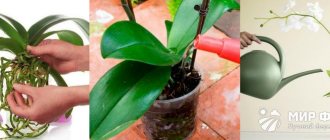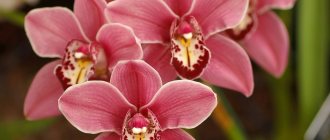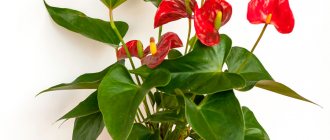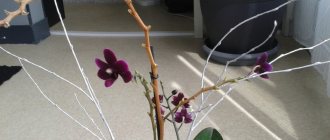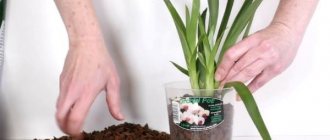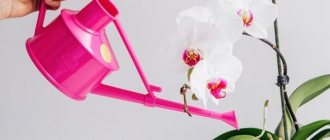- Growth period
Beautiful orchids, mainly various varieties of the Phalaenopsis genus, have long taken pride of place on the windowsills of apartments and private houses. These representatives of tropical flora captivated Russians with the shape of the flower, reminiscent of a butterfly, the variety of colors, the long flowering period, and the availability of purchase. Experienced flower growers know that to maintain a flowering appearance, a plant needs to be provided with a constant temperature, a certain regime of lighting, humidity, and fertilizing. We will tell you in the article what and how to feed an orchid.
Phalaenopsis (pictured) is one of the species most common in home floriculture
Ecological groups of orchids
In nature, orchids occupy different layers of the forest, therefore, they have different attitudes to growing conditions - lighting, humidity, soil nutrition, which must be taken into account when growing them indoors.
There are two groups: epiphytic and terrestrial.
Epiphytes
Prominent representatives: phalaenopsis, vanda, cattleya, dendrobium.
The name “epiphytes” from Greek means “on the plant”: representatives of this group live on other plants (phorophytes), mainly on trees. They are not parasites, since they use the phorophyte only as a place of residence, support, and receive moisture from the air and precipitation. In densely populated tropics, this feature helps them avoid competition for light and soil. Epiphytes, in addition to orchids, include mosses, lichens, and bromeliads.
Epiphytic orchids have free, photosynthetic roots, so they are grown in hanging baskets or clear glass pots.
Plants have little demand for soil nutrition. To provide all the necessary elements, it is enough to add special complex compounds.
Terrestrial orchids
Cymbidium, ludisia, bletilla, playone, and calantha growing in the lower tier of the forest receive nutrition from the rich forest litter, consisting of rotting leaves, grass, and animal excrement. Even at home, land plants require good nutrition, and some, for example, cymbidiums, even require organic matter rich in nitrogen.
Cymbidiums in nature grow both epiphytically on trees and on the ground under them.
Detailed instructions for planting different types of orchids can be found in the article on our website.
Reasons for the absence of a peduncle
The conditions for keeping an orchid depend on the variety and age of the plant. However, there are general care requirements, failure to comply with which will lead to a deterioration in the vital indicators of the flower. It is important to understand why the plant is unable to shoot an arrow.
Humidity level
Humidity level affects the appearance of flower stalks
Orchids grow in low humidity, but too dry air will prevent the plant from forming a flower stalk. Due to lack of moisture, the buds may fall off without opening. The humidity level depends on the orchid variety:
- Vanda flowering occurs when there is 70-80% moisture in the air during the day and 60% at night;
- Dendrobiums and Phlenopsis require 30-40% humidity;
- Cattleyas produce flower stalks at 40-50% humidity.
Air humidity is reduced by stimulating the flower using temperature changes. Otherwise, the root system will freeze and the plant will die.
Indoor light
Daylight hours for Phalaenopsis and Dendrobium should be at least 8 hours. In winter, the plant requires additional light sources. Special phytolamps are used for illumination. The amount of light required depends on the plant variety:
- Cymbidium produces a flower stalk under 12-hour light;
- Paphiopedilum requires light for 14 hours;
- Cattleyas grow with 12 hours of daylight.
Lack of lighting affects not only the plant’s ability to form a shoot. Without the right amount of light, the arrow will appear, but the plant will not bloom.
Watering mode
The arrow appears after stimulating the plant using the drought method. But, being without water for a long time, the flower will die. Orchids without moisture shed their arrows, saving water in the foliage and roots. Watering of phalaenopsis and dendrobium is carried out by spraying 1 r. in Week. For sympodial varieties, one spray every 10 days is enough. These include:
- Maxillaria;
- Ludisia;
- Vandu.
Temperature
Temperature is one of the main factors influencing the appearance of the arrow. The temperature difference method is the main way to stimulate an orchid. However, at low temperatures the flower sheds its peduncle. The heat level depends on the variety:
- Phalaenopsis will not form an arrow if the room temperature is below 16 °C;
- Dendrobium dies at temperatures below 14 °C;
- Cattleya and Wanda can withstand differences of up to 10 °C, but the room temperature should be above 12 °C.
Isn't it time to feed?
If there is a nutritional deficiency, the orchid itself will attract attention. The need to apply fertilizers is indicated by:
- long absence of flowering;
- the plant blooms, but the flowers are small and fall off;
- cessation of growth of new leaves or their shrinkage;
- change in leaf blade color (lightening);
- the lower leaves turn yellow, dry out, and die.
It’s easy to guess that it’s time to feed your orchid at home by the appearance of the plant.
What can't be used?
When evaluating a wide range of products, you need to know exactly which products cannot be used to fertilize an orchid. It is strictly not recommended to use fertilizers in the form of sticks or soil tablets. The fact is that they will dissolve unevenly in the ground, and areas where the content of nutrients is increased can damage the root system.
Experts advise abandoning traditional methods in the feeding process. The orchid is considered a very delicate flower, so compositions prepared independently can only cause harm.
Types of fertilizers
Traditionally, all fertilizers are divided into two groups: organic and mineral.
Organic matter is the waste of birds (pigeon, chicken droppings) and farm animals (manure). Usually an aqueous solution of rotted horse manure is used. But this is not always feasible. At home, the easiest way to feed orchids is with complex mineral fertilizers. Today, flower shops offer a good selection of compositions. From time to time you can turn to folk and specialized remedies. Their characteristics are presented in the table:
| Fertilizer type | Name and composition/purpose | Method of preparing the working solution and applying |
| Mineral fertilizers | Agricola Aqua , Pocon, Bona Forte , Flower Paradise , Fasco Complex preparations, including three main macroelements (nitrogen, phosphorus, potassium), microelements, amino acids in the concentrations required by plants | Detailed information on the preparation of the solution, dosages and methods of feeding is indicated in the instructions for the drug |
| Folk remedies | Banana peel Contains potassium, phosphorus, calcium, amino acids | The peel of one banana is poured with a liter of warm water and left for a day in a dark place. Water at the root, having previously diluted the nutrient solution with water 1:1 |
| Potato peelings Contain potassium, magnesium, nitrogen, phosphorus | Raw peelings are poured with boiling water, cooled, and filtered. Water at the root | |
| Garlic infusion is rich in vitamins and phytoncides that kill phytopathogens | 2 cloves of garlic are crushed, pour in 2 liters of water, leave for a day, filter and water at the root | |
| Sugar and yeast Sugar glucose and B vitamins contained in yeast are excellent flowering stimulants | 10 g of dry yeast (bag) and 3 tablespoons of sugar are diluted in 10 liters of warm water, left for 2 hours. Pots with plants are placed in the bathtub and watered abundantly | |
| Specialized means | Succinic acid Reanimation after stress, regeneration in case of damage, stimulation of leaf growth, root formation, flowering, soil improvement | The tablet (sold in pharmacies and gardening stores) is crushed and dissolved in a small amount of hot water. The resulting solution is added to 500 ml with water. Used for root and leaf irrigation, root treatment during transplantation |
| Cytokinin paste A hormonal agent that accelerates the appearance of inflorescences and children | In the spring, after removing the covering scales, the paste is applied pointwise to the waiting buds of the peduncle using a toothpick or a cotton swab. At the same time, the plant is fed with nitrogen. After 2 weeks the bud begins to grow | |
| B vitamins : B1 (thiamine) – stimulates root growth, accelerates flowering, increases flower size; B3 (nicotinic acid) – reanimates, accelerates flowering and the formation of new shoots; B6 (pyridoxine) – increases immunity, facilitates adaptation; B12 (cobalamin) – improves oxygen saturation, promotes the development of new flower stalks | Use a solution of 1 ampoule of any vitamin and a liter of water for watering and spraying once a month. |
There is a wide range of products on sale in different forms and volumes of domestic and foreign production.
Specialized fertilizers for orchids are preferable to universal complexes for flowering indoor plants, as they contain reduced concentrations of elements that can burn the roots.
Principles of flower maintenance before and during the appearance of buds - what is the difference?
Care in these different periods is of course different, let's compare:
- Care before the peduncle is released - while the plant is resting (not blooming), it needs to be carefully looked after so that it has the strength to bloom for a long time:
You need to water as the roots dry out.- Maintain the required humidity and temperature.
- Lighting must be active.
- Carefully and regularly inspect the flower for pests.
- You should not get carried away with fertilizing, otherwise the Orchid may begin to “fatten”, grow leaves and roots, but not bloom.
If it still doesn’t bloom for a long time, you need to create “stress,” that is, create completely uncomfortable conditions: either move it to a darker place, or create a slight “drought” (dramatically reduce watering). After such actions, flower stalks usually appear.
Read also Clematis white cloud pruning for winter
- Care during the release of the peduncle is no less thorough; of course, you need bright light, and the air humidity must be appropriate, the temperature regime must be observed, but after the peduncle has emerged, fertilizing should be immediately resumed at the required rate. At this moment they greatly influence the health of the entire Orchid bush in general and the quality of flowering in particular.
Stages of fertilizing
During certain phases of the life cycle, plants need different nutrients.
Growth period
During the period of active growth, orchids are fed with fertilizers with a high nitrogen content, which promotes the growth of green mass.
If you overdo it with the application of nitrogen, the plants will begin to “fat”, growing new leaves rather than flower stalks.
Budding phase
At the stage of laying new flower stalks and at the budding stage, the flower needs potassium and phosphorus.
Phosphorus-potassium fertilizers are considered a priority, as they contribute to the active formation of large buds and bright colors of flowers
Flowering period
During flowering, you can add potassium and trace elements. If the plant was not fertilized before the buds began to bloom, then there is no need to feed it, otherwise it will quickly bloom or begin to shed flowers and buds.
Rest period
Orchids survive winter in the dormant stage, which is facilitated by short daylight hours and lower air temperatures than in summer. This is when new flower buds are formed. You need to fertilize no more than once a month with a universal complex.
Phalaenopsis can bloom throughout the year, releasing arrow after arrow, which means they will have to be fertilized constantly
I will give an example of my first experience in growing phalaenopsis. A flower given for my birthday (presumably the Atlant variety - with a dark pink, closer to fuchsia, corolla color) occupied the kitchen window facing west, where it bloomed almost non-stop for two years. Then he had to go through two moves.
In a new apartment on the north-west window, the orchid tried to put out an arrow, but flowering did not happen: the buds fell off, the peduncle itself dried up, then the lower leaves began to die off (only 3 left). For three years I revived it: I sprayed it, in the summer I sent it to the open balcony (the same side of the world), I fed it along with other fertilizers for indoor flowers, which, as it turned out later, was completely wrong. And only a special fertilizer for orchids gave results: the phalaenopsis produced new roots, leaves and began to bloom again, which it now does regularly, but intermittently. I buy different types of Agricola (powder) for my plants - inexpensive but effective.
Pruning the peduncle
After the buds fall off, the old shoot is cut off to put the orchid into a dormant state. The plant is capable of shedding its peduncle, but the sooner the arrow is removed, the faster the orchid will bloom again. A frozen shoot will consume the sap of the plant, which is why the orchid will not bloom again.
Pruning is carried out 3-4 days after flowering ends. There are several rules for the procedure:
- For work, a sharp garden pruner is used, which is disinfected with alcohol.
- After pruning, a short shoot should remain, about 2-3 cm.
- The cut area is dried with cotton wool and treated with activated carbon.
Sometimes the shoot does not stop growing after the flowers fall. After some time, new buds form on such an arrow.
On such a shoot, children with roots and buds can also form. They are used for growing orchids by cuttings.
Methods and rules for applying fertilizing
The general rule for applying fertilizers is to pre-water the plant. Orchids are fed by root and foliar methods.
Fertilizers must be dissolved in settled water at room temperature.
Root feeding is carried out by watering the roots or immersing them in a solution. To do this, lower the pot with the orchid into a container (small basin) with a fertilizer solution for 10-15 minutes.
Foliar (leaf) spraying involves spraying the leaves on both sides with a solution from a spray bottle in the morning or evening. It is important not to get it on buds, flowers or in the axils of leaves. Foliar feeding is characterized by rapid results.
Is it necessary to do this?
The conditions in which the orchid grows contain a small volume of fertile soil. Therefore, she needs additional feeding.
Important ! If there is a lack of nutrition, the orchid will be susceptible to chlorosis. This is a disease in which photosynthesis in the leaves is impaired. They begin to turn yellow and fall off. The flower's development slows down.
To avoid this, it is recommended to timely apply the necessary fertilizers. This is especially true for fluorine and potassium. They are responsible for the splendor of flowering.
In order for young shoots and leaves to develop well, nitrogen is needed . But there are still a number of prohibitions:
- It is not recommended to apply root fertilizer to a weakened flower.
- The same applies to transplantation. This cannot be done immediately after the process. You need to let the plant get used to its new place of residence for about a month.
- It is strongly recommended not to fertilize the orchid immediately after purchase. It must adapt and bloom.
- If the flower is in the process of active flowering, fertilizers are not applied to the root system. Foliar feeding exclusively for leaves and aerial roots.
- Do not fertilize during the hot summer period.
You should take care of the plant and inspect it carefully. Before using any medication, you should carefully read its instructions. In it you will find all the useful information, including dosage.
When not to fertilize
Feeding is strictly contraindicated in the following cases:
- A newly purchased or gifted flower should be given at least 2 weeks time to adapt and only then begin caring for it according to all the rules.
- Immediately after the transplant. No matter how carefully the plant is transshipped, the roots will inevitably be damaged and will not be able to absorb the nutrient solution, which means that the elements will precipitate in the form of salts.
- It is better not to feed sick or weak plants; foliar feeding is acceptable.
- To avoid burns on the leaves, foliar feeding is not carried out in sunny weather.
Step-by-step care instructions
So, what to do next when the orchid has already produced a peduncle? If you correctly follow all the tips and recommendations for care, the flowering will delight our eyes for a long time. Let's look at the most important points:
- Choosing a place - after throwing out the peduncle, the pot must be placed on the windowsill of an eastern or western window, where there is light and not scorching sun rays. If there is only one window and it faces the south side of the house, then only shading will save you from burns and other problems.
- Temperature - in the autumn - winter period, the temperature should be maintained within 20 - 25 degrees, this is a comfortable temperature for blooming Orchids. Night temperature changes should be minimal.
- Humidity - required humidity: 60 - 70%, it is not so easy to achieve it during the heating season, the air in apartments becomes extremely dry. Of course, it would be good to use a special air humidifier, but this is ideal, and from available means, you can place a flower pot in a large container with water, at the bottom of which pebbles or expanded clay are poured so that the water evaporates.
Basic rules for keeping phalaenopsis
Phalaenopsis varieties sold in stores are planted in transparent pots filled with pieces of pine or pine bark; miniature forms are planted in sphagnum moss. This is the most suitable soil for epiphytic plants. It provides almost natural conditions: phalaenopsis grows by clinging to branches or tree bark with its roots.
The roots need sunlight and good ventilation, so this type of orchid is planted in transparent pots with numerous holes. Some lovers of exotic flowers grow it on a piece of bark - a block. It is better to place the new resident on a western or northern window.
